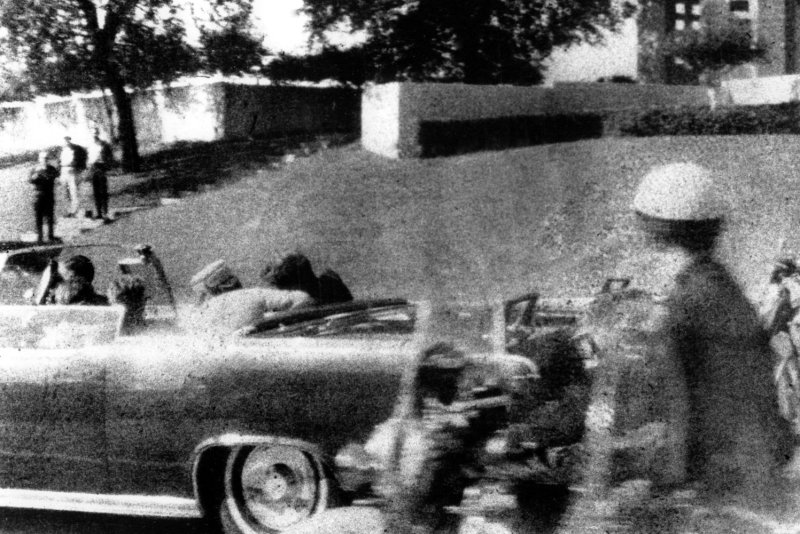1 of 4 | President John F. Kennedy slumps into the arms of his wife, Jackie, immediately after he was shot as his motorcade made its way through Dealey Plaza in Dallas, Texas on November 22, 1963. This Friday will mark the 50th anniversary of the assassination of President Kennedy on November 22, 1963. UPI/Files |
License Photo
DALLAS, Nov. 22 (UPI) -- My overall thought of the day I spent in the Dallas bureau of United Press International on Nov. 22, 1963, is no different a half century later than it was when I left the office in the middle of night and returned to my apartment and my bride of two months.
It was a surrealistic experience. That is what I thought then and, after the passage of time, I would not change that description.
Hours and hours floating by in a blur, as close to being in the eye of a hurricane as one could imagine. Outside the walls of that old, two-story brick building just northwest of downtown, the nation and the world was staggered by news that was unthinkable.
Inside those walls, business incredibly went on as it was designed to do.
The pace obviously quickened. Tension was high. But the task was performed that day as it was performed on other days.
That is one of the specific recollections I have carried through the years. From the moment veteran and imposing desk man Don Smith called out, "I've got a bulletin," the activities unfolded as if those in the office had been training all their lives for just such an incredible moment.
Smith took the first call from White House correspondent Merriman Smith with the shocking news that shots had been fired on the motorcade carrying President Kennedy through the streets of Dallas.
And UPI was fortunate, indeed, to have the people who were on hand that day to deal with the assorted compartments that made up a major bureau.
Jud Dixon, in charge of the broadcast desk, had white hair that spoke to his years on the job. Bud Bond, who ran the teletypesetter desk, had virtually no hair at all. The teletype operators were all seasoned veterans, although I had learned during my just-completed first year at UPI that there was no such thing as a young operator.
Scattered around the newsroom were people used to chronicling the news of the day.
Now, however, there was only one story and all efforts were aimed at providing the details that would become part of that story.
But somebody had to put that story on paper.
That somebody was a man who was made for the moment. He was the best breaking news writer I ever saw, that I ever will see and, in my opinion, ever existed.
Jack Fallon was news editor of the Southwest Division. He was overseer, teacher, counselor, decision maker and, when the time came, writer of eloquent prose. He eventually became UPI's foreign editor in New York and then went on to the highest levels of corporate public relations.
On this day, however, he sat at an old typewriter and, like a human machine, pounded out page after page of copy that not only informed the world what had happened but did so in a dramatic, yet smooth style that flowed from one paragraph to the next.
I know I did not fully appreciate the achievement as I saw it unfold that day. But now I consider it a once-in-a-lifetime experience that should be revered by those of us who have spent their lives trying to create readable sentences under the pressure of an instant deadline.
Hours after the gravity of the events had become clear, Jack was still creating new lead after new lead and showed no signs of slowing down. And then he did something that lives with me as the most memorable moment of the entire day.
He stopped his typing for a moment and looked across a small open space to the teletype operator who was taking her turn transmitting Jack's copy onto UPI's main news wire. She was Betty McClure, known to everyone in the bureau as Aunt Betty.
"Aunt Betty," Jack said. "I still can't believe this has happened."
With that, the man for whom no story was too big went right back to work -- setting an example followed by all in that room whose path that day intersected with history.
(Mike Rabun is a long-time UPI sports writer who was a young reporter in the Dallas UPI bureau when John F. Kennedy was assassinated on Nov. 22, 1963. Rabun was among the reporters who witnessed Jack Ruby fatally shooting Lee Harvey Oswald in the basement of the Dallas police station.)















